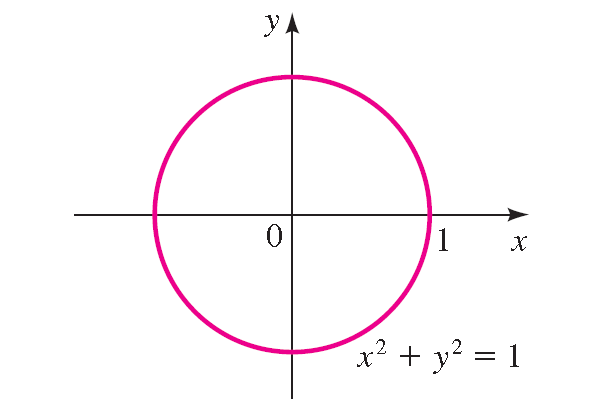THE UNIT CIRCLE
Subscribe to our ▶️ YouTube channel 🔴 for the latest videos, updates, and tips.
The set of points at a distance 1 from the origin is a circle of radius 1.

The unit circle is the circle of radius 1 centered at the origin in the xy-plane.
Its equation is
x2 + y2 = 1
A Point on the Unit Circle
Example 1 :
Show that the point A(4/5, -3/5) is on the unit circle.
Solution :
We have to show that this point satisfies the equation of the unit circle, that is, x2 + y2 = 1.
(4/5)2 + (-3/5)2 = 16/25 + 9/25
= (16 + 9)/25
= 25/25
= 1
So, A is on the unit circle.
Example 2 :
Show that the point B(√3/3, √6/3) is on the unit circle.
Solution :
We have to show that this point satisfies the equation of the unit circle, that is, x2 + y2 = 1.
(√3/3)2 + (√6/3)2 = 3/9 + 6/9
= (3 + 6)/9
= 9/9
= 1
So, P is on the unit circle.
Locating a Point on the Unit Circle
Example 3 :
The point P is on the unit circle. Find P(x, y) from the given information. The y-coordinate of P is -1/3 and the x-coordinate is positive.
Solution :
Because the point is on the unit circle, we have
x2 + (-1/3)2 = 1
x2 + 1/9 = 1
Subtract 1/9 from each side.
x2 = 1 - 1/9
x2 = 9/9 - 1/9
x2 = (9 - 1)/9
x2 = 8/9
Take square root on both sides.
x = ± 2√2/3
Because x-coordinate is negative,
x = 2√2/3
The point is
P(2√2/3, -1/3)
Example 4 :
If the the point P(√3/2, k) is on the unit circle in quadrant IV, find P(x, y).
Solution :
Because the point is on the unit circle, we have
(√3/2)2 + k2 = 1
3/4 + k2 = 1
Subtract 3/4 from each side.
k2 = 1 - 3/4
k2 = 4/4 - 3/4
k2 = (4 - 3)/4
k2 = 1/4
Take square root on both sides.
k = ± 1/2
Because the point is in quadrant IV and k is the y-coordinate, the value of k must be negative.
k = -1/2
The point is
P(√3/2, -1/2)
Example 5 :
The point P is on the unit circle. Find P(x, y) from the given information. The x-coordinate of P is -2/5 and P lies above the x-axis.
Solution :
Because the point is on the unit circle, we have
(-2/5)2 + y2 = 1
4/25 + y2 = 1
Subtract 4/25 from each side.
y2 = 1 - 4/25
y2 = 25/25 - 4/25
y2 = (25 - 4)/25
y2 = 21/25
Take square root on both sides.
y = ± √21/5
Because P lies above the x-axis, y-coordinate must be positive.
y = √21/5
The point is
P(-2/5, √21/5)
Example 6 :
The point P is on the unit circle. Find P(x, y) from the given information. The y-coordinate of P is -1/2 and P lies on the left side of y-axis.
Solution :
Because the point is on the unit circle, we have
x2 + (-1/2)2 = 1
x2 + 1/4 = 1
Subtract 1/4 from each side.
x2 = 1 - 1/4
x2 = 4/4 - 1/4
x2 = (4 - 1)/4
x2 = 3/4
Take square root on both sides.
x = ± √3/2
Because P lies on the left side of y-axis, x-coordinate must be negative.
x = -√3/2
The point is
P(-√3/2, -1/2)
Related Stuff
1. Terminal Points on the Unit Circle
2. Reference Number on the Unit Circle
3. Using Reference Number to Find terminal Points
Subscribe to our ▶️ YouTube channel 🔴 for the latest videos, updates, and tips.
Kindly mail your feedback to v4formath@gmail.com
We always appreciate your feedback.
©All rights reserved. onlinemath4all.com
Recent Articles
-
10 Hard SAT Math Questions (Part - 38)
Dec 08, 25 12:12 AM
10 Hard SAT Math Questions (Part - 38) -
SAT Math Practice
Dec 05, 25 04:04 AM
SAT Math Practice - Different Topics - Concept - Formulas - Example problems with step by step explanation -
10 Hard SAT Math Questions (Part - 37)
Dec 03, 25 07:02 AM
10 Hard SAT Math Questions (Part - 37)


